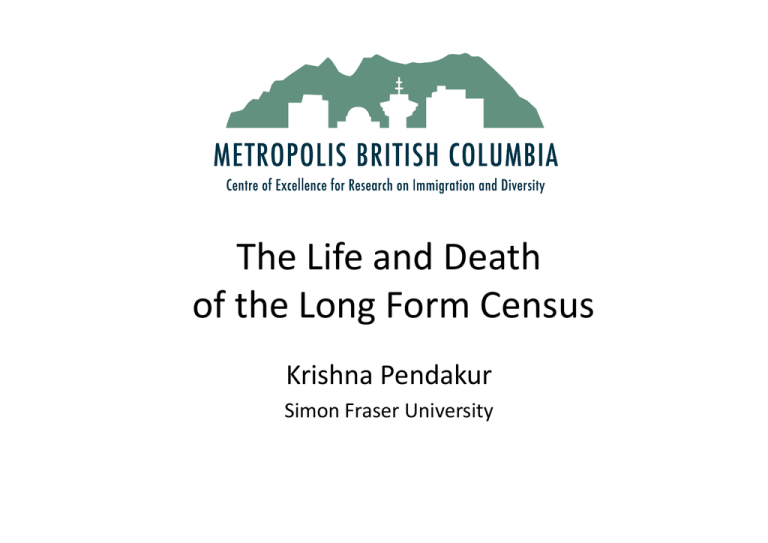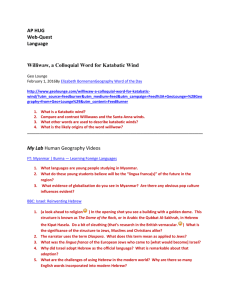The Life and Death of the Long Form Census Krishna Pendakur
advertisement

The Life and Death of the Long Form Census Krishna Pendakur Simon Fraser University The Long-Form Census • From 1961 to 2006, this was a census instrument that went out in addition to the short form received by the entire population of households. • It was sent to 20% of households in 2006. • It was long, taking up to an hour to complete. What Cost? • Roughly $500m per census year financial cost to government. • But the long form took about 3m hours to fill out. This implicit cost amounts to another $60m or so. • It asked questions people might not want to answer. – E.g.: income; religion; marital status of same-sex couples; What Kind of Information? • It collected information on many topics. – In 2006, questions on household work hours, pension income, commute times, ethnic origin and immigration status. – Typically, government departments interested in an issue would pay StatCan to add a question. • It was expensive, e.g., ethnicity questions cost Canadian Heritage upwards of $2m. – Since they had to pay, they only asked for questions with serious policy relevance, and usually financial importance. What Use? Public and Private Uses • Short form provides sufficient info for electoral stuff (e.g., riding sizes, etc). • Long form provided different types of data. – Government agencies used the data to calibrate their programming. • E.g., government assessments of the future cost of OAS/GIS depend heavily on data about current savings patterns of people at different income levels. – Private sector used the data for analysis and prediction. What Use? Small Groups • Because the long form went out to about 3m households, we could use it to learn about small groups in the population. – E.g., Aboriginal people are only 3% of the population, but there are 100,000 long forms. • In contrast, other data sources are radically smaller. – E.g., the Survey of Labour and Income Dynamics also collects data on ancestry and income, but has only 15,000 cases: about 450 Aboriginal people. What Use? Baselining Other Data • Other data sources are sample surveys. – These ask a small number of people in the country a bunch of questions. – The art of statistics is to use data from the sample to learn about the population in the country as a whole. Baselining • Some people do not respond to surveys. • The long form census allows StatCan to correct sample surveys for non-response, because the long form census was filled out by everyone who was asked. • Now, we will use the short form to correct for non-response. – But the short form has less data upon which to base the correction National Household Survey • The National Household Survey is voluntary, and so cannot be used to baseline other data sources. • It will go out to 4.5m households. They expect 50% to 60% response. • Its response rate will vary across income levels, ethnic groups, etc. • It will cost more than the long form. Long Form Data, Cities, Groups • With Long Form micro-data, we can learn about small groups in the population. – Cities; ethnic groups; age groups; etc • We can look at the earnings attainment of Canadianborn ethnic minorities, even though they’re less than 1% of the working age population. • Pendakur, Krishna and Ravi Pendakur, “Colour by Numbers”, Journal of International Migration and Integation, forthcoming. The Evilometer • We want to compare the earnings of white, visible minority and Aboriginal workers. • But, they have different characteristics: e.g., visible minority workers are more educated, Aboriginal workers are younger. • So, we use regression analysis to compare apples to apples, and measure earnings differentials between workers with similar age, education, place-ofresidence, etc. • We examine only Canadian-born workers. % difference in earnings between Aboriginal and visible minority vs white men and women, 1970 - 2005 0.05 -0.05 -0.15 -0.25 -0.35 -0.45 1970 1975 Female Aboriginal 1980 Female VM 1985 1990 Male Aboriginal 1995 2000 2005 Male VM Controls include: age, education, marital status, official language knowledge, household size and CMA of residence % difference in earnings between visible minority vs white men, Canada, Montreal, Toronto and Vancouver 1970 - 2005 0.00 -0.05 -0.10 -0.15 -0.20 -0.25 -0.30 1970 1975 Canada 1980 1985 Montreal 1990 Toronto 1995 2000 2005 Vancouver Controls include: age, education, marital status, official language knowledge, household size and CMA of residence % difference in earnings between visible minority vs white women, Canada, Montreal, Toronto and Vancouver 1970 - 2005 0.25 0.20 0.15 0.10 0.05 0.00 -0.05 -0.10 -0.15 -0.20 1970 1975 1980 Canada 1985 Montreal 1990 Toronto 1995 2000 2005 Vancouver Controls include: age, education, marital status, official language knowledge, household size and CMA of residence % difference in earnings between Aboriginal and White males, Canada, 1996 - 2006 -0.05 -0.15 -0.25 -0.35 -0.45 -0.55 1996 Reg. on-reserve 2001 Reg. off-res N. Amer. Indian 2006 Metis Aborig. Ancest(mult) % difference in earnings between Aboriginal and White Males, Montreal, 1996 - 2006 0.00 -0.05 -0.10 -0.15 -0.20 -0.25 -0.30 1996 Reg. off-res 2001 N. Amer. Indian 2006 Metis Aborig. Ancest(mult) % difference in earnings between Aboriginal and White females, Canada, 1996 - 2006 0.00 -0.05 -0.10 -0.15 -0.20 -0.25 -0.30 1996 Reg. on-reserve 2001 Reg. off-res N. Amer. Indian 2006 Metis Aborig. Ancest(mult) % difference in earnings between Aboriginal and White females, Montreal, 1996 - 2006 0.00 -0.05 -0.10 -0.15 -0.20 -0.25 -0.30 1996 Reg. off-res 2001 N. Amer. Indian 2006 Metis Aborig. Ancest(mult) Caribbean % difference in earnings, selected groups, males 2006 Vancouver Toronto Montreal Black Vancouver Toronto Montreal Chinese Vancouver Toronto Montreal S. Asian Vancouver Toronto Montreal -0.70 -0.60 -0.50 -0.40 -0.30 -0.20 -0.10 0.00 0.10 Caribbean % difference in earnings, selected groups females, 2006 Vancouver Toronto Montreal Black Vancouver Toronto Montreal Chinese Vancouver Toronto Montreal S. Asian Vancouver Toronto Montreal -0.25 -0.20 -0.15 -0.10 -0.05 0.00 0.05 0.10 0.15 0.20 0.25





